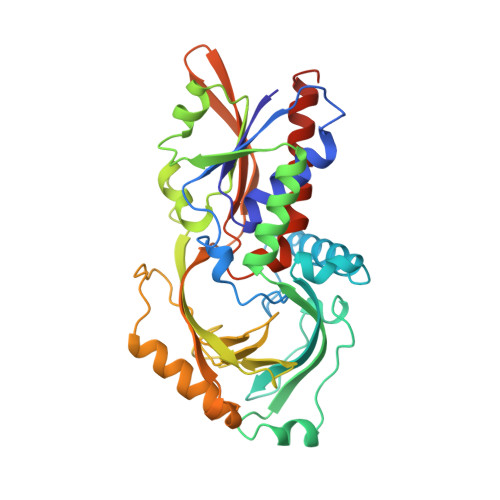Active site plasticity in D-amino acid oxidase: a crystallographic analysis.
Todone, F., Vanoni, M.A., Mozzarelli, A., Bolognesi, M., Coda, A., Curti, B., Mattevi, A.(1997) Biochemistry 36: 5853-5860
- PubMed: 9153426
- DOI: https://doi.org/10.1021/bi9630570
- Primary Citation of Related Structures:
1DAO, 1DDO - PubMed Abstract:
D-Amino acid oxidase (DAAO) is the prototype of the flavin-containing oxidases. It catalyzes the oxidative deamination of various D-amino acids, ranging from D-Ala to D-Trp. We have carried out the X-ray analysis of reduced DAAO in complex with the reaction product imino tryptophan (iTrp) and of the covalent adduct generated by the photoinduced reaction of the flavin with 3-methyl-2-oxobutyric acid (kVal). These structures were solved by combination of 8-fold density averaging and least-squares refinement techniques. The FAD redox state of DAAO crystals was assessed by single-crystal polarized absorption microspectrophotometry. iTrp binds to the reduced enzyme with the N, C alpha, C, and C beta atoms positioned 3.8 A from the re side of the flavin. The indole side chain points away from the cofactor and is bound in the active site through a rotation of Tyr224. This residue plays a crucial role in that it adapts its conformation to the size of the active site ligand, providing the enzyme with the plasticity required for binding a broad range of substrates. The iTrp binding mode is fully consistent with the proposal, inferred from the analysis of the native DAAO structure, that substrate oxidation occurs via direct hydride transfer from the C alpha to the flavin N5 atom. In this regard, it is remarkable that, even in the presence of the bulky iTrp ligand, the active center is made solvent inaccessible by loop 216-228. This loop is thought to switch between the "closed" conformation observed in the crystal structures and an "open" state required for substrate binding and product release. Loop closure is likely to have a role in catalysis by increasing the hydrophobicity of the active site, thus making the hydride transfer reaction more effective. Binding of kVal leads to keto acid decarboxylation and formation of a covalent bond between the keto acid C alpha and the flavin N5 atoms. Formation of this acyl adduct results in a nonplanar flavin, characterized by a 22 degrees angle between the pyrimidine and benzene rings. Thus, in addition to an adaptable substrate binding site, DAAO has the ability to bind a highly distorted cofactor. This ability is relevant for the enzyme's function as a highly efficient oxidase.
Organizational Affiliation:
Dipartimento di Genetica e Microbiologia, Universita di Pavia, Italy.















